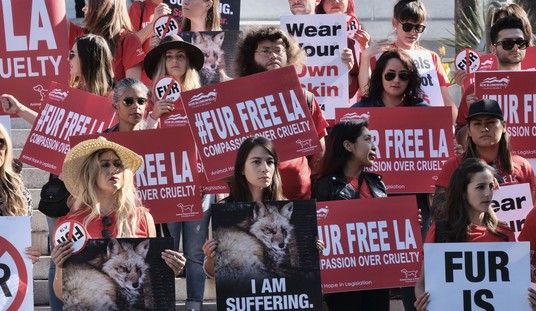President Barack Obama is continuing to tour the country touting his so-called “jobs bill,” insisting we have to pass this bill now in order to create jobs and save the economy. While Obama is touting more spending — and also more regulation — PJMedia has teamed up with AmericanJobCreators.com (AJC) to detail the impact of regulation on job creation in the United States, and to show how an actual jobs bill would require no spending, just a rollback of regulatory burdens.
We first looked at the impact of regulations on the trucking industry. Today’s article focuses on farming.
AJC — a project of House Republicans in general and the House Committee on Oversight and Government Reform in particular — spoke recently with a fourth-generation family farmer from California: Tom Deardorff II of Oxnard. He runs Deardorff Family Farms.
It’s a corporation — most family farms these days are. Farming is a business, and the farmers who don’t treat it that way don’t stay farmers very long. As AJC notes in their latest “Dispatch from the Road”:
While American families deserve clean air and water, America’s two million family farms live or die by it. Sustainable ecosystems power the more than $300 billion agriculture industry, feeding America and supporting about 1.2 million jobs. Just as overfishing puts fisherman out of work, poisoned land puts a farm out of business. Tom Deardorff II — Oxnard, CA small business owner and fourth generation family farmer — put it another way: “We are the first environmentalists.”
While they are not as close to the land as subsistence farmers, modern farmers still are connected to it in a way city dwellers, however environmentally conscious, cannot be. Once again, farmers who do not try to operate in a sustainable manner don’t remain farmers for long, and many of those two million family farmers have been on the same land for a century or more. Said Deardorff during an AmericanJobCreators.com visit to his family’s small produce packing facility:
My father created a sustainable, good business. We feel a very strong connection to the land and all our resources for that matter, whether land, water or labor. … It’s important for us to not only operate our business in a way that acknowledges and respects those resources, but also sustains them and makes them available for future generations.
The next generation depends on Mr. Deardorff both caring for his piece of California and providing for his 120 full-time workers and their families. A goal shared, in theory, by the 81,205 pages of federal government regulations.
But as these government dos-and-dont’s travel the 2,777 miles from Washington to reality, many turn into costly burdens, saddling small businesses like Deardorff Family Farms with higher costs and uncertain futures. Worse, meddling from the bureaucrats enforcing federal government regulations erodes the economic freedom and predictability on which Mr. Deardorff’s great-grandfather built the farm. Deardorff and many like him now find themselves running afoul of regulations such as the Clean Air Act or the Endangered Species Act. Said Deardorff:
I always thought my Dad went to work in a free-market economy. If you make the right decisions, you’re profitable. And if you make the wrong decisions, you’re not. … Now that I sit in his chair, I am amazed at how much I have to weave my way through government, government regulation and how that plays into our decision-making process.
Like any farming operation, the most important resource is water – a clean, reliable supply of water. Even though rain and snow were plentiful this year, government regulators have their hand on the spigot, writes AJC:
Mr. Deardorff can only watch as his water costs skyrocket, the unintended consequence of U.S. Endangered Species Act (ESA) regulations.
“We’re facing a doubling or potential tripling of our water charge because of requirements under the ESA to put in additional fish ladders, reduce streams, provide more water for habitat,” said Deardorff.
Not that those regulations are particularly effective:
Federal ESA regulations are meant to support the “conservation of threatened and endangered plants and animals and the habitats in which they are found,” according to the U.S. Environmental Protection Agency. But these well-intentioned rules simply haven’t worked in the real world: since ESA became law in 1973, a mere 10 of the 1300 species protected by ESA regulations have actually recovered. Effective or not, ESA compliance costs — like paying for fish ladders — are still passed onto farmers like Deardorff, who is at the mercy of ever-changing water regulations.
It’s not just water that’s the issue.
In May of 2010, I reported on a case where the EPA was requiring a burning plan in the Flint Hills region of Kansas. The Flint Hills, which stretch from northeast Kansas south to northeast Oklahoma, are the last remaining tall grass prairie in the world. A unique ecosystem which, ironically, has to burn every year in order to remain. As I wrote then:
In order for the waist-high bluestem grass to grow, each year in April the ranchers must burn the prairie. This helps to eliminate invasive species like the Eastern Red Cedar and other, shorter grasses which now hold sway in the western part of the state. It also burns off the dead grass from the year before.
This yearly burn is not only natural; it is required in order to maintain the highly fragile ecosystem of the tall-grass prairie. Only 4 percent of it remains these days, nearly 80 percent of that in Kansas.
This burning is important because ranchers from all over Kansas, Nebraska, Oklahoma, and Texas send their cattle to roam free in the hills for several months before rounding them up to take to feed lots for finishing — some of the best-tasting beef in the world is fed by that tall grass.
EPA decided to require the burn plan because the smoke from the fires can stretch as far as Tennessee and affect air quality in cities downwind. If Kansas couldn’t come up with a plan, EPA would stop the burns — and destroy an ecosystem.
According to Mike Beam, a vice president of the Kansas Livestock Association (KLA), they along with the Kansas Department of Health and Environment came up with a mostly voluntary plan which so far has kept the burns from being proscribed. However, in Wichita and Kansas City this year there was a problem with air quality after the burns, and the KLA is still waiting to hear if the request for an air quality waiver has been granted. If it’s not, then the ranchers may find themselves with a problem if Senator Jerry Moran (R-KS), who introduced similar legislation the last couple of years, can’t get a bill passed to exempt the Flint Hills from the Clean Air Act.
Deardorff commiserated:
“It just keeps coming from every direction,” said Deardorff grimly. “A lot of it, quite frankly, happens when people show up and say you’re not in compliance, or you go to buy a new piece of machinery and you find out that you have five new steps to do in order to buy that equipment.”
The cost of regulatory uncertainty is staggering. Take 2009, by no means unique in the modern history of American agriculture. California was parched by a “regulatory drought,” during which government stole water from farmers and diverted it to protect habitat for the three-inch-long Delta smelt. The casualties of the 2009 drought: 500,000 acres of working farmland lost, up to $2.2 billion in revenue lost, and at least 40,000 jobs lost in the San Joaquin Valley alone, according to April 2011 House Natural Resources Committee testimony.
The San Joaquin Valley is some of the most productive farmland in the world. So why would the federal government knowingly cause a job-killing “regulatory drought”? According to AJC, the reason is simple:
Special interest lawsuits that shatter the accepted regulatory process and push federal regulations beyond the realm of common sense. Recently, environmental zealots have struck “sue-and-settle” agreements with the Obama administration, prompting the U.S. Fish and Wildlife Service to issue a unilateral “biological opinion” that placed the full power of the federal government behind the three-inch-long smelt, leaving California farm workers and their families high and dry.
“Basically, the environmental community has sued our district claiming that they are in violation of their permitting because they have not installed certain additional measures to help protect a fish species,” Deardorff said.
We’ve seen that in Kansas as well, where an unholy alliance between environmental groups and ranchers has stopped power transmission lines — ironically enough, from wind farms — in the Flint Hills to cities out of state because the lines might affect the breeding habits of the lesser prairie chicken.
This regulatory bomb is blowing up industry after industry:
Agriculture is already a fragile industry. In 2009, America’s median farm income barely cracked $50,000. But the explosion of federal regulations under President Obama is making survival that much harder: 660,900 small businesses — from family farms to auto repair shops — closed in 2009. That year, the Obama administration proposed 2,044 new regulations. In 2010, proposed federal regulations jumped to 2,439.
As AJC points out, the growing Obama regulatory burden hits all businesses large and small, but hits small businesses like Deardorff Family Farms the hardest:
Average annual small business compliance costs have soared to more than $10,500 per employee. These job creators deserve common-sense regulatory relief, so that they can invest their hard-earned money and time into putting America back to work
If you have a story about what regulations are doing to your job or small business, visit AmericanJobCreators.com to speak out.









Join the conversation as a VIP Member